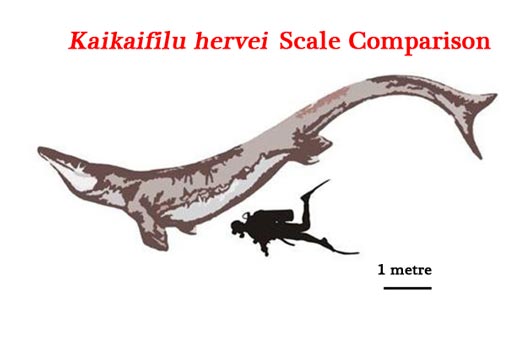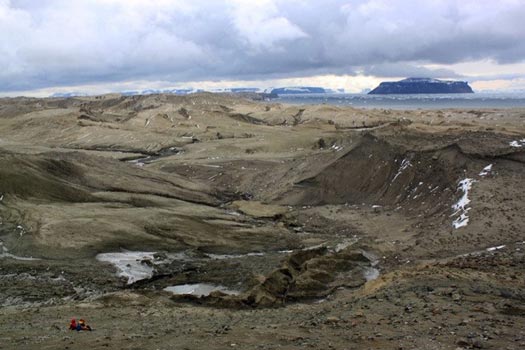Largest Mosasaur from Antarctica Described – Kaikaifilu hervei
A team of international researchers writing in the journal “Cretaceous Research”, have published details of the largest mosasaur to be identified from Upper Cretaceous strata in Antarctica. The newly described marine reptile has been named Kaikaifilu hervei, the scientists, which included Rodrigo Otero, a palaeontologist at the University of Chile and the lead researcher on the study, named the mosasaur after “Kai-Kai filú,” an almighty giant reptile that ruled the sea in legends from the Mapuche culture from southern Chile and Argentina.
Kaikaifilu hervei
The species name honours Francisco Hervé (University of Chile), who has done much to improve our understanding of the palaeoclimate of Chile and Antarctica.
Kaikaifilu hervei fossil material was found by a Chilean palaeontology expedition to the remote Seymour Island (sometimes called Marambio Island), off the Antarctic peninsula. This location has attracted a number of scientific expeditions in recent years as the strata exposed on parts of the island bridges the time period from the end of the Cretaceous and into the Palaeocene Epoch. The fossils, which include a fragmentary skull, plus a partial left humerus, elements from the jaw and about thirty teeth have been dated to around 66 million-years ago (López de Bertodano Formation).
The Estimated Size of Kaikaifilu hervei
Picture credit: Otero, R, A, Cretaceous Research with additional annotation by Everything Dinosaur
An Apex Predator
Based on better known mosasaurs, the scientists estimate that K. hervei reached lengths in excess of ten metres. It was probably an apex predator preying on the plesiosaurs that shared its shallow, marine environment. The fossil skull is only the second mosasaur skull known from Antarctica. The other mosasaur skull found in Antarctica represents the closely related, but earlier Taniwhasaurus antarcticus, which is estimated to have been about half the size of K. hervei. T. antarcticus fossils have been found on James Ross Island, part of the same archipelago as Seymour Island.
The Fossil Excavation Site on Seymour Island
Picture credit: Otero, R, A, Cretaceous Research
For models and replicas of plesiosaurs and mosasaurs: Papo Dinosaur and Prehistoric Animal Figures.
A Hunter of Plesiosaurs
Lead author of the study, Rodrigo Otero stated:
“Prior to this research, the known mosasaur remains from Antarctica provided no evidence for the presence of very large predators like Kaikaifilu, in an environment where plesiosaurs were especially abundant. The new find compliments one expected ecological element of the Antarctic ecosystem during the latest Cretaceous.”
Kaikaifilu has been classified as a member of the Tylosaurinae sub-family of the Mosasauridae, as such, it was closely related to the Tylosaurus genus known from the United States. The thirty or so teeth show heterogeneity (different shapes), this suggests that species of mosasaur named from just their different shaped teeth may in fact represent the Kaikaifilu genus and the researchers have postulated that the discovery of heterogeneous teeth on Seymour Island may lead to some revision amongst the Mosasauridae.
The scientific paper: “Kaikaifilu hervei gen. et sp. nov., A New Large Mosasaur (Squamata, Mosasauridae) from the Upper Maastrichtian of Antarctica”.
The website of Everything Dinosaur: Everything Dinosaur.








Leave A Comment